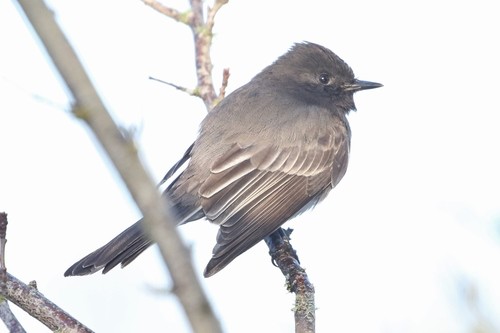Black Phoebe
A species of Phoebes, Also known as White-winged Phoebe Scientific name : Sayornis nigricans Genus : Phoebes
Black Phoebe, A species of Phoebes
Also known as:
White-winged Phoebe
Botanical name: Sayornis nigricans
Genus: Phoebes
Content
Description People often ask General Info
 Photo By silversea_starsong , used under CC-BY-NC-4.0 /Cropped and compressed from original
Photo By silversea_starsong , used under CC-BY-NC-4.0 /Cropped and compressed from original Description
Often spotted near creeks and ponds after you hear its sharp, whistling call, the small, plump black Phoebe is a sooty gray. Look for its white belly and squared tail to properly identify it. When perched, it wags its tail constantly. This bird feeds by taking short, quick flights to skim the water’s surface and snag an insect.
Size
16 cm
Life Expectancy
8 years
Nest Placement
Cliff
Clutch Size
1 - 6 eggs
Incubation Period
1 - 3 broods
Number of Broods
15 - 18 days
Nestling Period
18 - 21 days
Feeding Habits
Black Phoebe predominantly consumes various arthropods, including bees, wasps, flies, beetles, bugs, grasshoppers, damselflies, dragonflies, termites, and spiders. Its feeding technique involves perching low to spot and sally after prey, either by aerial pursuit or plucking from surfaces. Occasionally, it seizes small minnows and, rarely, consumes small berries.
Habitat
Black Phoebe prefer habitats in close proximity to water bodies like rivers, lakes, and coastal areas, including cliffs and Pacific beaches, as well as human-made environments such as park fountains and cattle tanks. Essential to these habitats is the availability of mud, crucial for the bird’s nest construction. They are adapted to a variety of altitudes, often residing in areas that support their nesting needs, even during winter migration which sometimes occurs at lower elevations.
Nest Behavior
Black Phoebe selects nest sites near water, with the male showing potential spots. The female constructs or refurbishes the nest alone, and there may be site fidelity. Nesting occurs above water or ground.
Nest Characteristics
Black Phoebe's nest is a mud shell lined with plant fibers, attached to vertical walls under eaves or on cliffs, 3–10 feet high. It measures 3–8 inches in height and width with a 1-inch deep cup.
Dite type
Insectivorous
People often ask
General Info
Feeding Habits
Bird food type
Bird Feeder Type

Platform
Sounds
Call
Recording location: Mexico
Song
Recording location: United States
Behavior
Black Phoebe's are known for their characteristic tail wagging after landing on a perched position. As insectivores, they engage in aerial hawking from a perch to catch prey, returning to the same or a nearby perch to consume it. Their daily routine includes forging for insects and caring for nestlings during breeding season. They exhibit strong territorial behavior, aggressively defending their space against other birds. Males perform elaborate courtship flights while nesting pairs act cooperatively to maintain territory and raise their young. They typically build their nests near water and utilize human structures. Unique to black Phoebe is their ability to adapt to human-altered landscapes, often observed in parklands and residential areas.
Distribution Area
The black phoebe breeds in the west and southwest United States, Mexico and Central America, and parts of South America. In Oregon it is found in river valleys on the Pacific coast, and in California on the western side of Coast Ranges. It breeds throughout the Colorado River valley and occasionally is found to the north in southern Nevada and southwestern Utah, as well as Arizona and central New Mexico. In Central America it breeds on Baja California, except for the central part of the peninsula, and on interior mainland Mexico southwest to Panama, excluding El Salvador. In South America it is found in the coastal mountains of Venezuela, through Colombia, Ecuador, and Peru, to western Bolivia and northwestern Argentina. 
Scientific Classification
Phylum
Chordates Class
Birds Order
Perching birds Family
Tyrant flycatchers Genus
Phoebes Species
Black Phoebe